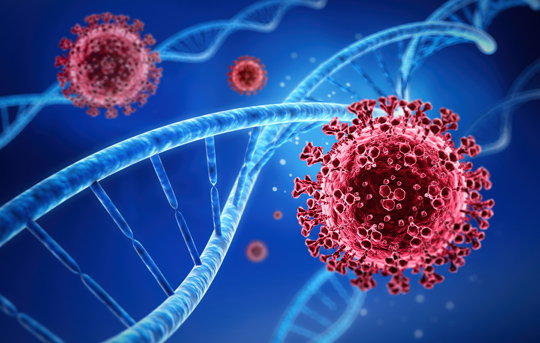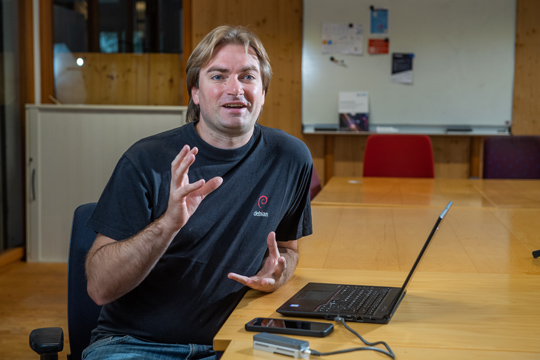The Community Against Covid-19
Freiburg, Oct 07, 2020
Always identical and therefore likely of significance: The SARS-CoV-2 virus always locates certain chemical groups in the same sites on its genome. Dr. Björn Grüning of the Department of Computer Science (INF) of the University of Freiburg and colleagues from bioinformatics, virology, and pharmacology have for the first time verified this characteristic in cells from human coronavirus patients. Direct RNA sequencing, also known as DRS, allows the epigenetic genome landscape of the virus to be seen. Grüning's data, now accessible worldwide on the "Galaxy" platform, could lead to new therapeutic approaches to treating Covid-19. The bioinformatician is also the leader of the Galaxy team in Freiburg. Jürgen Schickinger spoke with him about his work.
 "Galaxy" gives researchers all around the world access to data and research tools. As the novel coronavirus spread, the platform provided solid and proven infrastructure. Photo: Peter Schreiber Media/stock.adobe.com
"Galaxy" gives researchers all around the world access to data and research tools. As the novel coronavirus spread, the platform provided solid and proven infrastructure. Photo: Peter Schreiber Media/stock.adobe.com
Mr. Grüning, what is a "genome landscape?"
Björn Grüning: The genome contains epigenetic structures that are located on the genes. There are many modifications of this type. Small chemical groups, such as methylated, or acetylated residues, or others, are attached to the genetic building blocks known as nucleotides. Epigenetic characteristics influence how active or inactive modified genes are, and together, they form the landscape of modifications. Our landscape profile of the SARS-CoV-2 genome is a rough outline. We limited our focus to methylations exclusively.
Is the SARS-CoV-2 profile interesting?
In any case, its genome contains hundreds of methylations. Only one Korean research group has up to now published comparable results – so about ten to twenty strongly methylated sites – from a single genome sample. We analyzed and compared five samples: the Korean data, those of an Australian group, and data from three German samples that we investigated ourselves. Comparing enabled us to show for the first time that methylations in the SARS-CoV-2 genome are strongly conserved. The modifications can always be found at the same sites.
How could that lead to a new type of treatment?
If a pattern is conserved, it's also important. SARS-CoV-2 makes an effort every time to ensure methylated groups are always added at identical locations. Therefore, the modifications are potential attack targets for new Covid-19 treatments.
How would they be attacked?
First of all, the enzyme with which SARS-CoV-2 locates the methylations would have to be well-characterized. Researchers would then, in principle, be able to construct molecules that could inhibit this enzyme. There wouldn't be further methylations in the genome of the virus. What we don't know, however, is if that would completely knock out SARS-CoV-2 or would the virus only be slowed? Or would the virus do just as well without the methylations as with them? That still needs to be investigated.
Why is bioinformatics the source of this exciting approach?
Since February 2020, our team has had a few ongoing corona projects, such as those investigating sequence level genome differences or the protein structure of the virus. The methylation project got kicked off when, through DRS, so direct RNA sequencing, and MinION - I stumbled over the appropriate device for analysis. The genetic material of SARS-CoV-2 is made up of RNA. We were able to use DRS to access the methylations.
 Researchers can use the work of the bioinformatician Björn Grüning as the basis for developing a drug for treating Covid-19. Photo: Klaus Polkowski
Researchers can use the work of the bioinformatician Björn Grüning as the basis for developing a drug for treating Covid-19. Photo: Klaus Polkowski
What's so special about DRS?
RNA and DNA are related molecules. They are very similar, but not identical. For sequencing purposes, RNA is usually transcribed into cDNA first, then decoded. During the transcription, however, information about methylation and other modifications gets lost. The DRS process removes the cDNA detour. During DRS, the RNA chain winds itself through a protein pore. Its voltage changes according to which genetic building block is located in the pore just then. The MinION device is about as big as a USB stick can do DRS in real time. Even during the procedure, you're seeing how the sequence comes out the other side.
And how do you get methylation data from that?
The voltage of an unmethylated nucleotide differs from that of a methylated one. The signals we get are a zigzag line of voltage peaks. When we compare the lines of unmodified RNA with those that have been modified, a few of the peaks simply look different. But there's far more to it in detail. We have to figure out what the difference in the peak means – is it methylation or one of many other possible modifications? The DRS process is still quite new. There are few tools available to analyze the data. Besides, enormous masses of it are generated – more than a terabyte for just the five samples. In order to interpret this flood of data correctly, we must develop a new model with machine learning algorithms.
What is the source of the sample material from human cells?
We got them through Prof. Dr. Ralf Gilsbach, who earlier worked at the Institute of Pharmacology of the University of Freiburg. Gilsbach is a DRS specialist. He established contact with virology at the University of Freiburg Medical Center. And they agreed right away. Dr. Jonas Fuchs, of Prof. Dr. Georg Kochs's working group, infected epithelial lung cells with SARS-CoV-2 from different patients. He went on to multiply the genetic material and isolate it. The sequence data was then sent to bioinformatics, where the doctoral candidate Milad Miladi analyzed it. Sounds pretty complicated, wouldn't you say? But all-in-all, the whole project only took about six weeks. Favorable circumstances and a great team joined forces to do that.
What's Galaxy's role in this?
Galaxy is of major importance and not just for networking in the scientific community. The Platform has more than 18 thousand registered users. They can upload data there and access more than 2500 different tools to analyze or display data. The University of Freiburg's infrastructure supports the platform – including the supercomputer of IT Services (RZ) and the computing capacities of "de.NBI," the German Network for Bioinformatics Infrastructure. Without them, we wouldn't be able to evaluate efficiently masses of data like those generated by our cooperation. We will possibly examine a few more SARS-CoV-2 genomes for methylation in order to confirm our result. Perhaps we'll have a look at acetylations or other epigenetic modifications as well. But we'll leave developing an "epigenetic" drug to combat the pathogen to others. Our data are globally accessible on Galaxy. I think it would be super if a research group would develop an active ingredient using this as a basis.
A kaleidoscopic view of corona: Video podcast with Björn Grüning (German with English subtitles)

